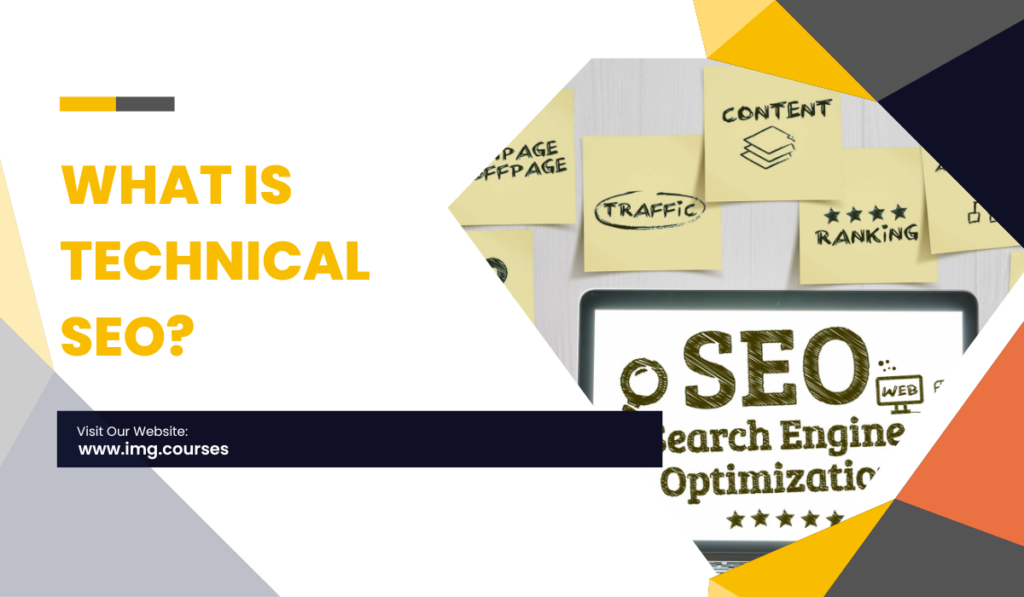
Like any discipline, add the word ‘technical,’ and you’re immediately looking at something a bit more advanced.
If you plan to be well versed in SEO, for example, you need to have a firm grasp of the technicalities behind it.
SEO is, in essence, a form of organic digital marketing. A technique to increase natural brand exposure for what you’re offering – be it information, a product, or a service.
It’s never enough to just sprinkle your content with some juicy keywords and wait for the sales to roll in.
You need to understand how the very structure of your digital assets plays just as vital a role in your success, as a killer link-building strategy.
So that’s what we’ll work through here – what is technical SEO, why does it matter, and how learning technical SEO can grow a business online?
The Definition of Technical SEO
The easiest way to differentiate technical SEO is to split it away from the content side of things.
You’ve got your copy, metadata, blog posts, rich snippets, your social media profile links, and all the other content components.
That provides the intricate web of data that a search engine uses to assess what you’re all about, how valuable the information is, and when it will show you to search engine users.
Before you can even get there, though, you need the bots to crawl your site and find the data to start with.
Even if you’ve got excellent content, without the basic digital structure behind it you’re going nowhere fast.
Step forward, technical SEO.
Components of a Technical SEO Strategy
Technical SEO is like the springboard that launches your content right at the search engine.
It’s your front-of-house host inviting the guests to come in, take a look around, and sample our best stuff!
On a basic level, if a search engine can’t find your website, index the pages, crawl, and render the data, you’re not going to rank.
However, it gets more complex than that – because getting indexed isn’t the end of it.
The components of technical SEO all intertwine. They include:
- Page security
- Mobile optimization
- Loading speeds
- Content duplications
- Data structure
- XML sitemaps
- 404 pages, or other bad links
- URL format
- Depth of content
- 301-page redirects
- JavaScript
You don’t have to be perfect (a duplicate CTA here and there isn’t the end of the world). But, the better every element of your technical SEO, the easier it is for the search engine bots to crawl your content, the happier they are with what they find, and the better your chances of ranking.
Why Technical SEO Matters
Technical SEO matters because it tells the search engine how valuable your content is.
You can look at it as a digital house of cards, and if one falls, the others do too:
- On-page SEO is your content and optimizations.
- Off-page SEO is promotions and marketing.
- Technical SEO relates to indexing and crawling.
Therefore, the first baby step of technical SEO focuses on the structure of your website.
If you have terrible site structure, it doesn’t matter how fast your page loads – search engines aren’t going to pay you much attention.
Content quality may be king, but it won’t make it anywhere close to the throne without the technical SEO to back it up.
Structure will dictate a lot of the decisions you make about technical SEO, so things like constructing a sitemap all come second to getting the setup right from the beginning.
In short, your on-page, off-page, and technical SEO are equal partners, and one without the others doesn’t function.
How to Use Technical SEO to Grow Your Business

Technical SEO is the backbone of any effective SEO strategy. It ensures your website is built and structured so search engines can easily access, understand, and rank. By optimizing your technical SEO, you enhance the performance, visibility, and user experience of your site, which directly translates into higher traffic, better engagement, and increased revenue.
Here’s how to use technical SEO to grow your business:
1. Improve Website Speed and Performance
Page speed is a critical ranking factor affecting search engine rankings and user experience. A faster website not only ranks higher but also keeps users engaged.
How it helps grow your business: Faster loading pages lead to lower bounce rates, higher user engagement, and ultimately more conversions.
What to do: Optimize your site by compressing images, leveraging browser caching, reducing server response time, and minifying CSS, JavaScript, and HTML. Tools like Google PageSpeed Insights can help you pinpoint areas for improvement.
2. Ensure Mobile-Friendliness with Responsive Design
With Google’s mobile-first indexing, your site’s mobile version is what search engines prioritize when determining rankings. Ensuring your site is mobile-friendly is non-negotiable.
How it helps grow your business: A mobile-friendly site provides a seamless user experience, increasing the chances visitors will convert into customers.
What to do: Use a responsive design to ensure your website adapts to various screen sizes and devices. Test your site’s usability with Google’s Mobile-Friendly Test tool and fix any issues.
3. Enhance Crawlability and Indexing
If search engines can’t find and index your pages, they won’t appear in search results. Ensuring your website is accessible, crawlable, and fully indexable is crucial to technical SEO.
How it helps grow your business: By improving crawlability and indexing, you ensure that search engines can access and rank your valuable content, increasing visibility.
What to do: Optimize your robots.txt file and XML sitemap to guide search engines through your site. Remove any pages or links that lead to dead ends (404 errors), and use 301 redirects to guide users and search engines to the correct pages when URLs change.
4. Optimize for Core Web Vitals
Google introduced Core Web Vitals as a way to measure user experience across three key metrics: page loading speed (LCP), interactivity (FID), and visual stability (CLS). Ensuring your website scores well on these metrics is now essential for SEO success.
How it helps grow your business: Good Core Web Vitals mean a better user experience, leading to higher rankings, more traffic, and better engagement, which drives revenue growth.
What to do: Use tools like Google Search Console and Lighthouse to track your Core Web Vitals performance and make the necessary improvements, such as optimizing images, reducing JavaScript, and enhancing server response times.
5. Leverage Structured Data and Schema Markup
Structured data and schema markup help search engines better understand your content. They can also enhance your website’s appearance in search results, often leading to rich snippets (like star ratings or FAQ accordions) that attract more attention.
How it helps grow your business: Enhanced search result listings through rich snippets improve click-through rates (CTR), bringing more potential customers to your site.
What to do: Implement structured data using schema.org for elements like product reviews, FAQs, and business information. Use Google’s Structured Data Testing Tool to ensure it’s working correctly.
6. Fix Duplicate Content Issues
Duplicate content can confuse search engines, diluting the ranking power of your pages. It can also lead to poor user experiences if they encounter redundant or repeated content.
How it helps grow your business: Resolving duplicate content issues ensures your most important pages rank better, attracting more traffic and increasing conversions.
What to do: Use canonical tags to tell search engines which version of a page to index. Ensure your URL structure doesn’t allow multiple versions of the same content (e.g., with or without “www” or trailing slashes).
7. Use HTTPS for a Secure Website
Google has confirmed that HTTPS is a ranking signal, and users prefer secure browsing sites. HTTPS ensures a safe connection between your website and users’ browsers, protecting sensitive data like personal information and credit card details.
How it helps grow your business: A secure site builds trust with users, encouraging them to complete transactions or share personal information. It also prevents potential ranking penalties for being insecure.
What to do: Install an SSL certificate on your website to enable HTTPS. Once implemented, update your internal links to point to the HTTPS version, and use 301 redirects for any old HTTP URLs.
8. Optimize Your Site’s Internal Linking Structure
Internal linking helps search engines understand the structure of your website and how different pages relate to each other. It also distributes link equity across your site, helping more important pages rank better.
How it helps grow your business: Better internal linking allows users (and search engines) to navigate your site more efficiently, which increases page views, reduces bounce rates, and helps distribute SEO value to your key pages.
What to do: Use descriptive anchor text with relevant keywords and strategically place internal links to guide users to related or high-value pages. Ensure your most important pages are a few clicks away from the homepage.
9. Utilize 301 Redirects Correctly
When you change URLs or remove pages, 301 redirects are essential to maintain SEO value and user experience. A 301 redirect ensures that visitors and search engines are seamlessly directed to the right place, preserving the link equity of your original page.
How it helps grow your business: Properly implementing 301 redirects prevents traffic loss and retains the SEO power of old pages that have been moved or replaced.
What to do: Use 301 redirects whenever you permanently change a URL. Avoid creating redirect chains or loops, as these can negatively impact user experience and SEO performance.
10. Conduct Regular Technical SEO Audits
SEO is not a one-and-done task. Regular audits are essential to ensure that your website remains technically sound and continues to perform well.
How it helps grow your business: A technical SEO audit uncovers issues like broken links, slow page speeds, or security vulnerabilities that, if addressed, can help your rankings and traffic.
What to do: Use tools like Google Search Console, Screaming Frog, and Ahrefs to conduct comprehensive SEO audits. Regularly check for crawl errors, duplicate content, missing meta tags, or broken links, and fix any issues you uncover.
Conclusion: Combining Technical SEO with Content and Off-page SEO
In the conclusion, you could emphasize the synergy between technical, on-page, and off-page SEO:
Reinforce the idea that a solid technical foundation is crucial for maximizing the impact of your on-page and off-page SEO efforts.
Mention how these different aspects of SEO work together to improve visibility, user experience, and search engine rankings.

